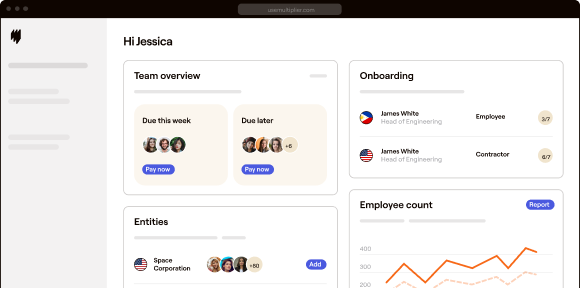At the end of last year, team Multiplier produced a predictions report for HR leaders—State of Work | Predictions Report for HR Leaders in 2024. This comprehensive report dives into crucial stats and insights that shape the current state of employment and identifies HR trends that will dictate the future of work. The report consists of ten chapters, each representing a prediction for HR leaders in 2024.
Part one of our report deep dive covered chapters one through four: siloed workforces, skills-first recruitment, work-life integration, and artificial intelligence. So, let’s dive back in and see what the remaining chapters have to offer.
Businesses must solve the productivity puzzle
During the pandemic, employee productivity took a substantial hit. But it’s difficult to judge businesses amid a global crisis, especially considering many were working remotely for the first time or not working at all. However, the pandemic was a little while ago, and things are yet to normalize.
Workplace disruption has led to job satisfaction declining in recent years as many employees express uncertainty about their roles and responsibilities. In turn, this symptom negatively impacts employee engagement levels. In 2023, unengaged or actively disengaged employees cost $1.9 trillion in lost productivity.
That’s a brand new stat from Gallup, showing that productivity is indeed a top priority for businesses in 2024, and failing to react will be costly. Entire countries have struggled with productivity since the pandemic, so it’s not a new problem. It’s an ongoing concern that business leaders must address and understand before they can solve the puzzle.
If productivity is the goal, what’s the solution? For some, hybrid models and a return to the office (RTO) will be trialed and likely implemented as an alternative to remote work. However, automation and various AI tools already demonstrate value for streamlining processes and boosting productivity. A tactic that, once feared, now offers almost every industry a solution to work faster while freeing up time for employees.
“I am a big fan of AI assisting humans and making the workforce more productive. Every engineer at Multiplier currently uses AI-based solutions, which help them code better and faster, increasing their productivity by 20-30%.”
– Sagar Khatri, Multiplier Co-Founder/CEO (from The Debrief)
Improved HR processes increase productivity
To counter the many challenges of the modern workplace, HR leaders will adopt a holistic view and approach to enhancing and optimizing productivity. The key is to improve their ability to gauge real productivity by implementing data-driven goal-setting, closely monitoring outputs, and gaining a clear understanding of their organization’s hiring needs.
We live in a data-driven world, from products to entertainment to social media. Every company uses data analytics to understand customers better and forecast future needs. For example, Microsoft uses data to highlight peak performance periods and adjust their work structure and schedule accordingly. Very smart, Mr Gates!
The same holds true for generative artificial intelligence (GAI). Research shows that a Fortune 500 company implementing GAI decreased its onboarding duration from ten months to just two months, all while achieving a remarkable 30% improvement in work quality. Whether you love, hate, or are indifferent to using AI—stats like that are undeniable for leaders needing enhanced productivity.
Internal mobility: Levelling up, not leaving
Internal mobility has consistently challenged employers, but the reasons are mainly qualitative. Unfortunately, employees often don’t get the appropriate support from senior management when transferring to and from internal roles. However, statistics show that significant change may be on the horizon.
- According to a 2023 report, nearly half of the employers in the United States (49.5%) expressed their intention to hire internally or promote existing employees.
- A staggering 81% of recruiters acknowledge that internal recruiting is pivotal for enhancing employee retention.
- A study of 11,000 internal hires at a Fortune 100 company found that, over five years, internal candidates hired through informal processes consistently exhibit lower performance levels than internal candidates hired through formal postings.
That final statistic is from 2015, long before the pandemic and our current productivity woes. In 2024, we have a vast wealth of technology and insights to enable and inspire widespread change. It just requires employers to trust and empower employees to rise up the ranks.
Will 2024 be a new era for internal mobility?
Amidst a global talent crunch, financial uncertainty is rife throughout all industries. Companies want to cut costs wherever possible; the first casualties are often training and development budgets. Therefore, internal recruitment enhances employee engagement and fulfillment by fostering skill acquisition without incurring excessive costs.
“Today’s teams are globally distributed, however. While this has many advantages, one disadvantage is the absence of such immediate communication. That’s why existing employees, who have undergone strong onboarding processes, have been with the company for a long time, and have established relationships in the business, find it easier to be promoted and assume new responsibilities.”
– Sagar Khatri, Multiplier Co-Founder/CEO (from The Debrief)
The talent crunch is problematic, to say the least. Surveys show that as much as 77% of employers are struggling to fill roles. HR has evolved quickly to counter this issue by implementing new technologies and adopting more modern and streamlined processes. This is already helping companies streamline skills-first recruitment, enhance employee development, and ensure straightforward and autonomous internal mobility.
Employee health & well-being is a priority
This is less of a prediction and more of a hopeful thought for the coming year. It’s a hopeful prediction. The health and well-being of employees should be a top priority every year and every day in the workplace. This year, companies will continue investing in employee well-being, emphasizing its importance through improved processes and awareness.
Retaining (and finding) talent is a top priority for businesses this year, and investing in employee health and well-being is vital for boosting engagement, job satisfaction, and brand reputation. All of which prove valuable for retention and attracting new blood.
Virgin Pulse’s Workplace Health and Well-Being Priorities Survey supports this, with the responses of over 600 HR leaders showing that well-being efforts and programs offer crucial benefits and ROI. Surveys such as this demonstrate the ever-evolving nature of the working world and its shifting priorities. Here are a few key stats from the Virgin Pulse report.
- 70% of HR executives think well-being strategies yield a return on investment (ROI).
- Before the pandemic, a global survey indicated that only 23% could assess the effectiveness of well-being initiatives.
- A significant number of respondents (59%) have expressed their intention to implement well-being programs over the next year.
- 67% said that employee participation and engagement improved, attributing well-being programs to positive impacts on employee behavior.
Supporting their health and well-being is critical to ensure employees are as productive and engaged as possible. This is driven by economic factors that change the way companies are structured. Sagar Khatri (Multiplier’s CEO and Co-Founder) offered some insight in a recent edition of The Debrief.
“What matters is their engagement, motivation levels, and, in truth, their financial reward. It’s crucial that you invest in the people you want to keep and ensure that they stay with you and help build your organization.”
– Sagar Khatri, Multiplier Co-Founder/CEO
The loss of valuable employees can have devastating consequences, highlighting the vitality of employee retention. As Sagar said, it’s crucial to invest in people if you hope they’ll stay with you and play a role in helping your business grow. Employers must understand that by ensuring their workforce is operating at its best, they’re also establishing a solid foundation for keeping and attracting top talent.
Although we see progress and several steps in the right direction for the future of work, there’s still a long way to go. In 2024 and beyond, employee well-being will continue demonstrating its value for workers and ensuring companies have what and who they need to grow.
The evolution of the gig economy
The COVID-19 pandemic has brought about an unprecedented global shift in the perception of work and the workplace. In many ways, these changes are here to stay. According to a study by Upwork, American freelancers made a remarkable $1.35 trillion contribution to the US economy in 2022, which is $50 billion more than the previous year.
The number of US freelancers was tipped to reach around 73 million by the end of 2023. A three million person increase from the previous year. These figures highlight the profound impact of remote work on employment dynamics and the economy as a whole.
Professionals wanting alternatives to full-time jobs contributed much to this growth. The gig economy shows promise while offering a solution for the talent crunch, plus a new level of flexibility and autonomy for employees. And we all know how crucial freedom and flexibility is for modern workers.
- 79% of full-time independent workers are happier working independently than in conventional work structures.
- 70% of the workforce will work remotely five days a week by 2025.
- 40% of the global workforce will work from home by 2025.
These stats show how the gig economy has become a lifeline for workers unsatisfied with traditional employment. It’s like a breath of fresh air, bringing happiness and productivity to those looking for something different. And guess what? It’s also a lifesaver for businesses with skill gaps.
The gig economy to the rescue?
73% of US workers intended to work within the gig economy at the start of 2023. That’s a large crowd full of potential for employers. For this reason, businesses are looking to implement “blended” teams of employees and freelancers, which are becoming increasingly more prevalent.
Organizations understand the immense value that on-demand talent brings to the table. This includes the flexibility and specialized skills needed to thrive in an uncertain economy. By seamlessly integrating freelancers into the workforce when required, companies can cultivate work environments that are more diverse, agile, and collaborative.
“Increasingly, people are choosing to monetize their skill sets and share them with more than one company. As a company, you may not need 100% of their time; you just need their skills.”
– Sagar Khatri, Multiplier Co-Founder/CEO
Fortunately, the wealth of technology and its many advances and applications further support freelancer recruitment and onboarding, ensuring it’s a seamless and productive experience. Additionally, tools with data analytics allow employers to monitor and optimize their approach and processes involving freelancers.
Freelancers should prioritize identifying and leveraging in-demand skills to find new job opportunities. Critical skills in 2024 include AI, cybersecurity, data analysis, remote project management, and content creation. These roles are crucial for modern business growth and can be outsourced to top-tier freelancers, reducing internal expenses for training, benefits, and other costs associated with traditional employees.
Diversity, equity, and inclusion: Recognition is crucial
The global market for DEI solutions amounted to $9.3 billion in 2020, with projections indicating a doubling of that figure to $15.4 billion by 2026. This surge reflects the escalating urgency and substantial investments that businesses are dedicating to these transformative initiatives.
For today’s organizations, prioritizing DEI goes beyond a mere obligation. It stands as a fundamental attribute and the essence of an employer of choice.
DEI in 2024
LinkedIn’s 2023 Workforce Report shows a remarkable 168% rise in the recruitment of Chief Diversity and Inclusion Officer (CDO) roles since 2019. Despite this significant surge in hiring, the anticipated impact and transformative changes are yet to be seen.
Additionally, a Gallup report shows that 97% of HR leaders implemented changes to bolster their company’s DEI efforts. But only 37% of employees agreed, highlighting a significant disparity between the two groups. Despite the increasing focus on HR and DEI efforts, there’s a noticeable gap between their intended goals and actual impact. Much of this can be attributed to the lack of recognition.
“Diversity, equity, and inclusion are not just buzzwords; they are the cornerstones of innovation and progress. To me, as a female leader, embracing and championing these values within our organizations is not just a moral imperative but also a strategic advantage. This advantage fuels creativity, fosters resilience, and drives sustainable success.”
– Lina Szaks, SVP of Operations at Multiplier
Recognition can spark real change
A diverse workforce fosters a multicultural environment that empowers professionals to express themselves freely and unleash their creativity. Recognition profoundly impacts employees, generating inspiration, engagement, and genuine job satisfaction. However, a uniform approach no longer works as everyone possesses unique qualities and perspectives.
Workplace stress is a persistent challenge as employers seek innovative ways to enhance employee engagement. In 2023, companies embraced a more “humanized” approach to diversity, equity, and inclusion, centering their efforts around prioritizing their people when creating processes.
Gallup’s report also shows that:
- Employees are four times more likely to develop a deep connection with their company’s culture when recognition takes precedence.
- Employees are 20 times more likely to be engaged if they receive positive recognition.
- 72% of employees who get recognition for outstanding work claim that employers must also recognize “the little things.”
Authentic recognition requires organizations to foster diverse and inclusive environments, continuously improving the employee experience. Employers should acknowledge past mistakes, address employee neglect, and prioritize accountability for workforce evolution.
Employers must also prioritize health and well-being initiatives to combat burnout and minimize turnover during the talent shortage. It damages your business reputation and sends the wrong message to your employees when your top talent departs due to inadequate DEI policies.
Return to the office (RTO)
In a 2023 survey of 1000+ business decision-makers, 90% of companies stated intent to return to the office by year-end. 72% also reported improved revenue due to RTO. As we’ve mentioned, businesses are in a productivity slump, so the potential of reclaiming lost productivity and revenue is an appealing prospect. Things are already ramping up in 2024, with IBM telling managers to return to the office for at least three days a week or find new jobs.
But there’s understandable resistance, with most employees (98%) wanting to work remotely and would recommend it to others. Workers like the freedom and flexibility of the post-pandemic world, but businesses want the productivity and communication of the office. Naturally, this puts HR professionals in a tough spot, and the stats surrounding this subject don’t help matters.
- Approximately 28% of employers may issue threats of termination to employees who don’t return to the office.
- 39% of employees expressed their intent to resign if returning to the office is obligatory.
“The reality is, it’s about preferences. Some people prefer to work in our office, some prefer to work in a cafe, while others prefer to work out of their homes. If you want to be an employer of choice, give employees the option to work from anywhere.”
– Sagar Khatri, Multiplier Co-Founder/CEO
Is hybrid work the best solution for all?
Our report also highlighted the employment tug-of-war—employees like to work from home, and businesses want to RTO—and the need for HR leaders to provide a solution. While this is a lofty goal, achieving it will take a step closer to satisfying all parties. One solution that’s already demonstrating value is hybrid work.
Hybrid models continue to offer value to simple and complex operations as they evolve to suit the needs of employers and employees. However, implementing significant changes requires new policies and technologies to guarantee efficiency, engagement, fairness, and productivity.
Gartner predicted that 39% of knowledge workers would be hybrid by the end of 2023, an employment model that balances freedom and flexibility with in-person collaboration and communication. Hybrid work will become increasingly prevalent and considered a “go-to” for businesses that require increased engagement, job satisfaction, productivity, and innovation.
Hybrid work structures have great potential, but HR leaders must implement the appropriate technology and collaborate with employees to develop processes. Technology will drive progress, particularly through performance monitoring and comprehensive data analysis. Embracing hybrid models should be an ever-evolving and innovative process with the potential to revolutionize how we work.
Furthermore, HR and workplace leaders must receive training to embrace strategies and innovative approaches in the context of remote and hybrid models. The landscape of the modern workplace has undergone significant transformations, as demonstrated in our report. Leaders must prioritize effective communication and empathy while leveraging performance management to enhance workforce productivity and engagement.
Experience the future of HR with Multiplier
Multiplier’s State of Work: Predictions Report for HR Leaders in 2024 offers a wide range of insight into the future of work, supported by reports and surveys from leaders in the HR space. The employment landscape is on the cusp of massive changes, and 2024 will be a telling year for what the future holds for the workplace and technology. In a future where business growth and expansion are critical, you need the right tools for the job.
Want to boost your business productivity with top talent from around the world? Well, look no further than Multiplier’s advanced global employment platform! Talk to our experts and schedule a demo today.







